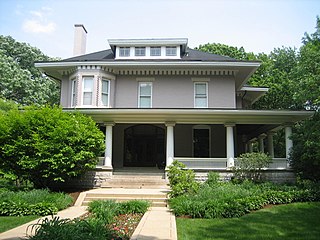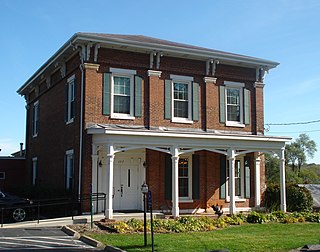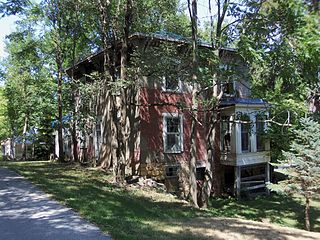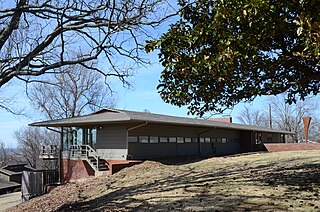
The William H. Copeland House is a home located in the Chicago suburb of Oak Park, Illinois, United States. In 1909 the home underwent a remodeling designed by famous American architect Frank Lloyd Wright. The original Italianate home was built in the 1870s. Dr. William H. Copeland commissioned Wright for the remodel and Wright's original vision of the project proposed a three-story Prairie house. That version was rejected and the result was the more subdued, less severely Prairie, William H. Copeland House. On the exterior the most significant alteration by Wright was the addition of a low-pitched hip roof. The house has been listed as a contributing property to a U.S. Registered Historic District since 1973.

Mount Pleasant is a farm complex located in the Town of Pembroke, New York, United States, east of the hamlet of Indian Falls. It was established in the mid-19th century.

The Mary and Eliza Freeman Houses are historic residences at 352-4 and 358-60 Main Street in Bridgeport, Connecticut. The simple, clapboard-covered dwellings were built in 1848 in what became known as Little Liberia, a neighborhood settled by free blacks starting in the first quarter of the nineteenth century. As the last surviving houses of this neighborhood on their original foundations, these were added to the National Register of Historic Places on February 22, 1999. The houses are the oldest remaining houses in Connecticut built by free blacks, before the state completed its gradual abolition of slavery in 1848. The homes and nearby Walter's Memorial A.M.E. Zion Church are also listed sites on the Connecticut Freedom Trail.

The Dawley House is an historic property located in Le Claire, Iowa, United States, and has been listed on the National Register of Historic Places since 1979. It is the former home of Daniel V. Dawley. The property is part of the Houses of Mississippi River Men Thematic Resource, which covers the homes of men from Le Claire who worked on the Mississippi River as riverboat captains, pilots, builders and owners.

The Kattenbracker House is an historic building located in Le Claire, Iowa, United States. The house has been listed on the National Register of Historic Places since 1979. The property is part of the Houses of Mississippi River Men Thematic Resource, which covers the homes of men from LeClaire who worked on the Mississippi River as riverboat captains, pilots, builders and owners.

House at 218 Dearborn Street is a historic home located in the Black Rock neighborhood of Buffalo in Erie County, New York. It was built about 1880, and is a one-story, wood-frame shotgun-style workers cottage on a limestone foundation. It is three bays wide and has a low pitched gable roof. It features a hipped roof front porch with decorative spandrels, added about 1890. Also on the property is a shed dated to about 1890.

C.L. and Bessie G. McGhee House is a historic home located at 103 West Mason Street in Franklinton, Franklin County, North Carolina. It was built in 1911, and is a 1 1/2-story, three bay, blended Colonial Revival / Bungalow style frame dwelling. The house has a steeply pitched hipped roof and stands on a full brick foundation. It features a one-story hip-roof wraparound porch and the interior has original wallpaper by M. H. Birge Company of Buffalo, New York. Also on the property is a contributing outbuilding.

Harden Thomas Martin House is a historic home located at Greensboro, Guilford County, North Carolina. It was built in 1909, and is a 2 1/2-story, double pile, Colonial Revival style frame dwelling. It consists of a main block with shallow, gable-roofed projections; two one-story, hip-roofed rear wings; and a porte-cochere. The front facade features a bowed, two-story portico supported by four fluted Ionic order columns with large terra cotta capitals. Also on the property are two contributing frame outbuildings.

Morrison–Campbell House is a historic home located near Harmony, Iredell County, North Carolina. It was built about 1860, and is a two-story, three bay by two bay, Late Greek Revival style frame dwelling. It has a shallow gable roof, exterior brick end chimneys, and a one-story hip roofed front facade porch. Also on the property is a contributing log smokehouse built in 1880.

The Willis Noll House is a historic house at 531 North Sequoyah Drive in Fayetteville, Arkansas. Located on a steeply-sloping lot, it presents a single-story to the front and two to the rear. Its foundation, chimney, and part of its walls are red brick, while the rest is finished in vertical siding. The house is a long narrow rectangle capped by a shallow-pitch gable-on-hip roof. Built in 1950, it is one of five houses in Arkansas designed by native son Edward Durell Stone and the only one in his home town. The house shows the influence of Frank Lloyd Wright on Stone's work, with the open floor plan, expansive windows, and the use of natural materials.

Pool Rock Plantation is a historic plantation house located near Williamsboro, Vance County, North Carolina. It consists of two, two-story sections. The older was built in 1757 by James Mitchell, an immigrant from Lunenburg County, Virginia. His daughter, Amy Mitchell, married Michael Satterwhite in the house in 1759. It is a two-story, three bay, Federal style frame structure. It forms the rear section. About 1855, a more ornate two-story, three bay, Italianate style frame structure attributed to Jacob W. Holt (1811-1880). The later section has a shallow hipped roof and overhanging eaves. The two sections are joined by a two-story hallway linker. Also on the property is a contributing one-story, hip roof office building.

Ward-Applewhite-Thompson House is a historic plantation house located near Stantonsburg, Wilson County, North Carolina. It was built about 1859, and is a boxy two-story, three bay, double pile, Greek Revival style frame dwelling. It has a shallow hipped roof and wrap-around Colonial Revival style porch with Doric order columns added about 1900. Attached to the rear of the house is a gable roofed one-story kitchen connected by a breezeway. Also on the property are a number of contributing outbuildings including two packhouses, stable, and tobacco barns.

Western New York Wine Company, also known as the Philip Argus House and Winery, is a historic winery located at Pulteney, Steuben County, New York. The main building consists of a home and winery building built in 1886 and 1890, respectively. The buildings were connected in the 1970s. It is a two-story, "L"-shaped, fieldstone dwelling with an attached three-story, fieldstone winery. Both elements have cross-gable roofs. Also on the property is a contributing English barn built about 1880. The winery remains in operation as Chateau Frank.

Augustus S. Tyron House, also known as the Tryon-Prentice-Powers House, is a historic home located at Le Roy, Genesee County, New York. It was built in 1867, and is a two-story, Italianate style frame dwelling with a recessed two-story wing. It features a hipped roof with overhanging eaves and brackets, bay window with second story porch, and a full-width, one-story porch, also with decorative brackets.

Martin–Fitch House and Asa Fitch Jr. Laboratory, also known as the Fitch House, is a historic home and laboratory located at Salem, Washington County, New York. The house was built about 1787, and modified between about 1796 and 1812, and again about 1830. It is a two-story, five bay, Late Georgian style heavy timber frame dwelling. It has a steep hipped slate roof with dormers and two interior chimneys. The Asa Fitch, Jr. Laboratory, or “Bug House,” was built about 1825 and enlarged about 1860. It is a small two-story, gable roofed frame rectangular building with a lean-to addition. Also on the property are the contributing barn and milk house. It was the home and laboratory of Asa Fitch (1809-1879), first occupational entomologist in the U.S.

Cyrus Rexford House is a historic home located at Rexford, Saratoga County, New York. It consists of a three-story, Stick style main block built in 1883, with a 1 1/2-story rear block built about 1850. It also has a one-story rear ell. The main block has a steeply pitched hipped roof with bracketed overhang. The house features an elaborate mix of decorative detailing and polychrome pain scheme. Also on the property are the contributing carriage house and gambrel roofed barn.

Beaver Falls Grange Hall No. 554 is a historic Grange hall located at Beaver Falls in Lewis County, New York. It was built in 1892, and is a two-story, wood-frame building measuring 30 feet wide and 60 feet deep. It sits on a fieldstone foundation and has a front gable roof. It features a one-story, hipped roof front porch. The first floor was converted to a store in 1915.

Jacob H. Patten House is a historic home located in the former village of Lansingburgh at Troy, Rensselaer County, New York. It was built in 1881–1882, and is a two-story, two-bay-wide by three-bay-deep, Italianate style brick dwelling. It sits on a brick and stone foundation and a pitched roof hidden by a low parapet. The front facade features a one-story, shallow, hipped roof porch with square, chamfered columns and brackets. Also on the property is a contributing two-story carriage house.

First Congregational Church of Walton is a historic Congregational church located at Walton, Delaware County, New York. The earliest section of the church was built in 1840, and was extended by 16 feet in 1862. It is of wood-frame construction with clapboard siding and a gable roof with an engaged, projecting three-stage bell tower. The church was remodeled in 1931. The front facade features a pedimented projecting portico supported by four Doric order columns added in 1931. Attached to the church is the Church House, consisting of a two-story connector wing with a gabled roof and a larger-scale, two-story pavilion with a hipped roof and gabled dormer.

Murphy Grist Mill, also known as the Old Mill, is a historic grist mill located at Poughquag, Dutchess County, New York. It was built in 1889, and is a two-story, front-gabled, vernacular frame building with a stone and concrete foundation. It has a one-story, hipped roof porch supported by simple contemporary posts. Also on the property are the contributing ruins of a stone mill dam. During his 1909 campaign for New York State Senate, Franklin Delano Roosevelt gave a political speech from the porch of the mill building. The mill remained in use until about 1940. Franklin Delano Roosevelt Jr. purchased the property in 1949 and the mill was used primarily for storage. During the mid-1980s, it was given to the Town of Beekman and restoration began in 2014.



















